Der FC St. Pauli gewinnt in einem wirklich ansehnlichen Spiel gegen Greuther Fürth. Zwei frühe Tore kurz nach Anpfiff halfen dabei enorm. Die Art und Weise wie der Vorsprung gegen eines der besten Teams der 2.Liga gehalten wurde, lässt sich als reife Leistung bezeichnen. Denn bis auf den Anschlusstreffer ließ der FCSP in der zweiten Halbzeit wenig bis gar nichts zu.
(Titelbild: Peter Böhmer)
Die Aufstellung
Zwei Veränderungen gab es im Vergleich zur Niederlage in Düsseldorf. Für Tore Reginiussen rückte Philipp Ziereis wieder in die Startelf. Reginiussen war nicht ganz fit, weshalb er auch gar nicht im Kader auftauchte. Auf der Sechs startete Rico Benatelli wieder anstelle von Afeez Aremu.
Keine Wechsel gab es bei Greuther Fürth. Der angeschlagene Paul Jaeckel wurde noch rechtzeitig wieder fit und konnte starten. Nach dem überzeugenden 3-0 zuletzt gegen Osnabrück gab es nicht viel Anlass zum wechseln.
Somit starteten beide Teams im zuletzt praktiziertem 4-4-2 mit einer Mittelfeldraute. Ich hatte im Vorbericht überlegt, dass der FCSP als Reaktion auf die ziemlich starke Raute von Fürth mit einem 3-5-2 reagieren könnte. Das wäre aber natürlich die Variante „Wir stellen uns auf den Gegner ein, weil wir unserem Spiel nicht vollends vertrauen“ – ich muss mich auch nach nun inzwischen mehr als drei Monaten daran gewöhnen, dass der FCSP ebenfalls ein funktionierendes Spiel hat und sich nicht immer komplett dem Gegner anpassen muss. Das ich so denke liegt wohl daran, dass es jahrelang genauso praktiziert wurde. Welche Wohltat, das dem nicht mehr so ist.
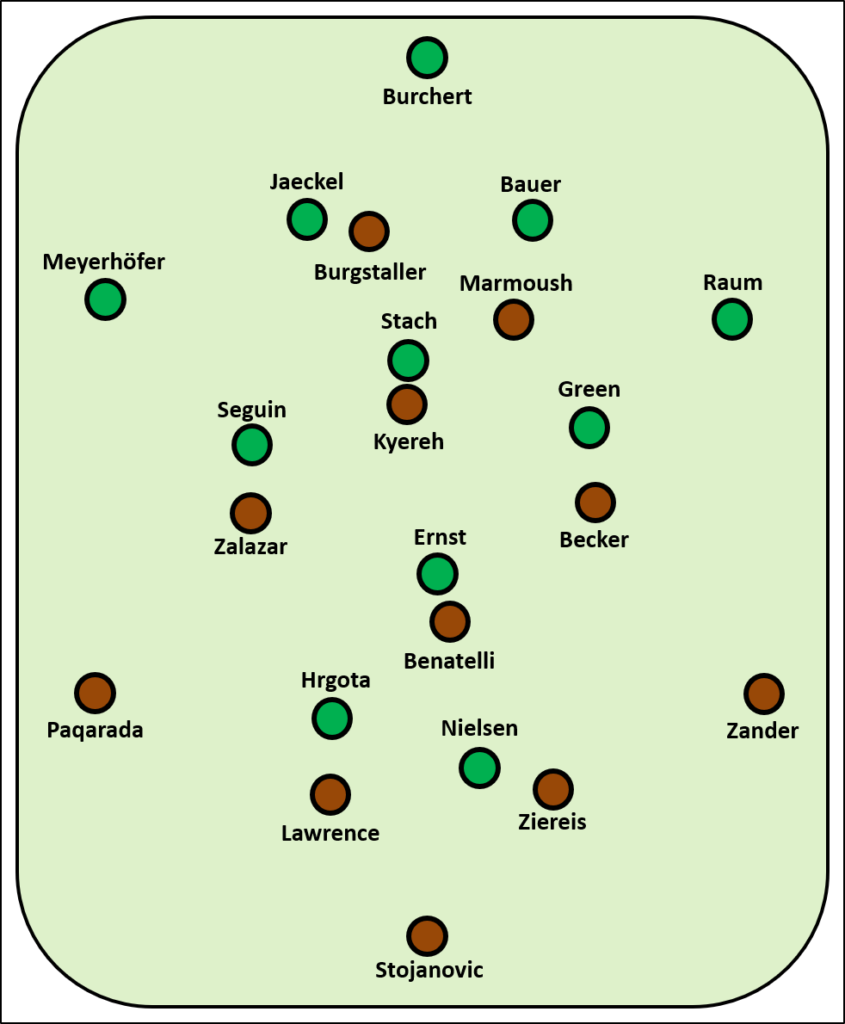
Spieglein, Spieglein…
Schon bemerkenswert wie ähnlich beide Teams den Spielaufbau gestalteten, aber dann doch, trotz gleicher Grundordnung unterschiedliche Wege gingen. Beide Teams pressten relativ hoch, Greuther Fürth sogar sehr hoch, sodass gerade der FCSP ein paar Probleme mit dem geordneten Aufbauspiel hatte. Fürth hingegen konnte das hohe Pressing des FCSP einige Male umspielen und brach dabei meist immer auf der Außenbahn durch. Allerdings scheiterte das Team sehr oft an der gut arbeitenden Defensivzentrale des FCSP. Das soll aber das Pressing des FC St. Pauli gar nicht schlechtreden, denn es gibt inzwischen einen deutlichen Schritt nach vorne beim Verhalten im Team-Verbund.
Dass die Außenverteidiger der Gegner meist von den Halbpositionen, also zuletzt immer von Zalazar und Becker angelaufen werden, hatte ich ja bereits mehrfach beschrieben. Dieses Anlaufverhalten gibt es auch weiterhin. Allerdings nur, wenn die Außenverteidiger noch nahe genug am eigenen Tor stehen. Wenn sie hingegen weiter vorne positioniert sind, dann übernehmen die Außenverteidiger des FCSP das Anlaufen, während die Spieler auf den Halbpositionen im Zentrum bleiben. Dieses Anlaufverhalten sorgt dafür, dass die gesamte FCSP-Viererkette deutlich auf die ballnahe Seite schieben muss. Das kann zu Fehlern führen, wenn die Abstände nicht stimmen. Allerdings ist der Vorteil, wenn die Halbpositionen zentral bleiben können enorm und der FCSP hat es schon ganz gut hinbekommen im Team das Pressing so zu variieren und zu verschieben.
Gegen Fürth konnten Zalazar und Becker somit häufig im Zentrum bleiben. Wenn sie dennoch mal auf die Außenverteidiger pressten (wenn diese tief in der eigenen Hälfte standen), waren es Zander und Paqarada, welche die Deckung der Gegenspieler im Zentrum übernahmen, sich also auf die Halbposition bewegten. Diese Übergabe der Deckungsaufgaben im Zentrum funktionierte ziemlich gut, sodass Greuther Fürth sein eigentlich sehr rund laufendes Aufbauspiel zwar teilweise durchbrachte, aber eben nicht mehr in der Häufigkeit wie in den meisten Spielen dieser Saison.
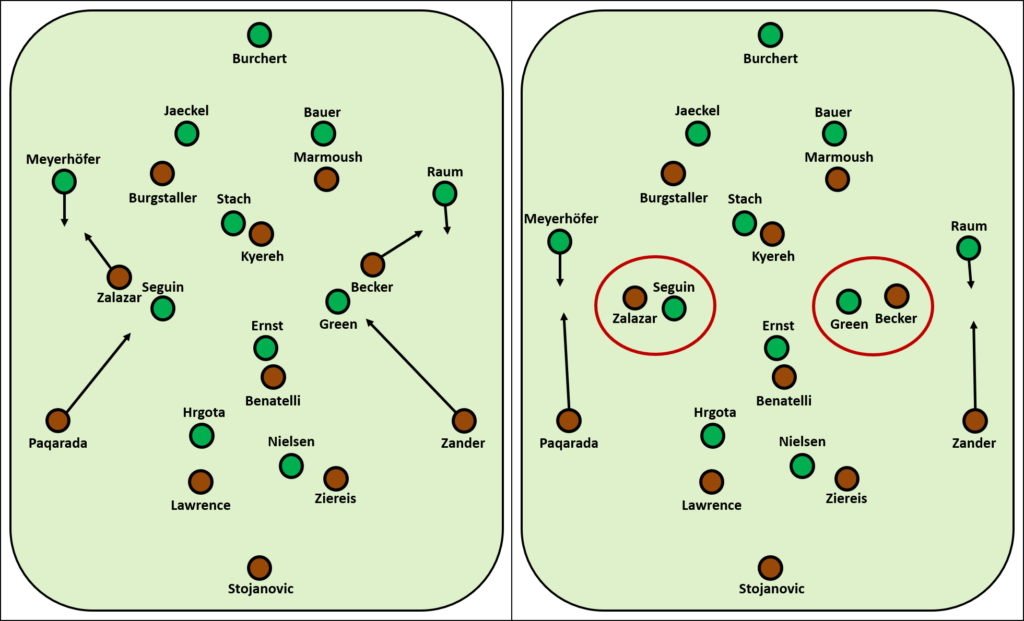
links: Anlaufverhalten bei eher tiefstehenden Außenverteidigern – bei dieser Konstellation waren es weiterhin die Halbpositionen, die anliefen. Die FCSP-Außenverteidiger rückten dann vor auf die Halbpositionen.
rechts: Anlaufverhalten bei hochstehenden Außenverteidigern – Zentrum bleibt dicht und die Außenverteidiger schieben direkt rauf auf die gegnerischen Außenverteidiger. Hierbei muss die eigene Viererkette mit verschieben, da sich sonst im Rücken Räume für tiefe Läufe ergeben.
Oops… they did it again
Joa, der Spielverlauf ist dann so in etwa auch zu erwarten gewesen, sag ich mal ganz locker. Zumindest von all denen, die diesen Artikel zu den Leistungen in den einzelnen Spielabschnitten gelesen haben. Der FC St. Pauli zeigte einmal mehr, dass er besonders in den ersten Minuten eines Spiels richtig stark ist und ging nicht unverdient durch Luca Zander im Anschluss an einen Eckball in Führung. Drei Torschüsse in der Anfangsviertelstunde gab der FCSP ab, Fürth keinen einzigen (xG: 0.47 – 0.0).
Aber wer den Artikel gelesen hat, wusste auch, dass der FCSP in der letzten Viertelstunde der ersten Halbzeit alles andere als dominant ist. So auch gestern als Fürth in diesem Abschnitt vier Torschüsse abfeuerte und der FCSP keinen. Die Viertelstunde vor der Pause war also mal wieder die schlechteste des FCSP (xG: 0.0 – 0.56).
Ich kann mir weiterhin nicht erklären, wie dieser Unterschied zustande kommt, was dazu führt, dass der FCSP immer stark aus, aber schwach in die Kabine kommt. Aber natürlich nehme ich jede Führung gerne mit. Denn das ist so ziemlich das beste, was dem FCSP passieren kann:
Was Stefan Leitl sagt
„Um hier zu gewinnen, musst Du in Führung gehen“ – Sicher haben es andere Trainer auch schon gedacht, aber bisher hat es noch niemand so deutlich ausgesprochen, wie Stefan Leitl, Trainer von Greuther Fürth, auf der Pressekonferenz nach dem Spiel. Der machte, gut angefressen ob der Niederlage und da ihm viermal die nahezu identische Frage gestellt wurde, ganz deutlich, wie schwer ein Spiel gegen den FCSP in Rückstand zu spielen ist. Denn das Prunkstück ist und bleibt das sehr gute Umschaltspiel. Liegt ein Team zurück und riskiert offensiv mehr, ergeben sich zwangsläufig mehr und mehr Räume für Konter. Diese Räume hat der FCSP in dieser Saison immer nutzen können, da die Spieler im Team tempomäßig bärenstark sind. Die frühen Tore spielen den Stärken des FCSP also perfekt in die Karten.
„Das entscheidende Tor nicht zu früh schießen“ sagt Blog-Kollege Maik immer gerne. Für den FCSP kann ein Spiel aktuell jedoch nicht besser laufen als mit einer frühen Führung, da sie häufig genug bereits eine Art Vorentscheidung ist.
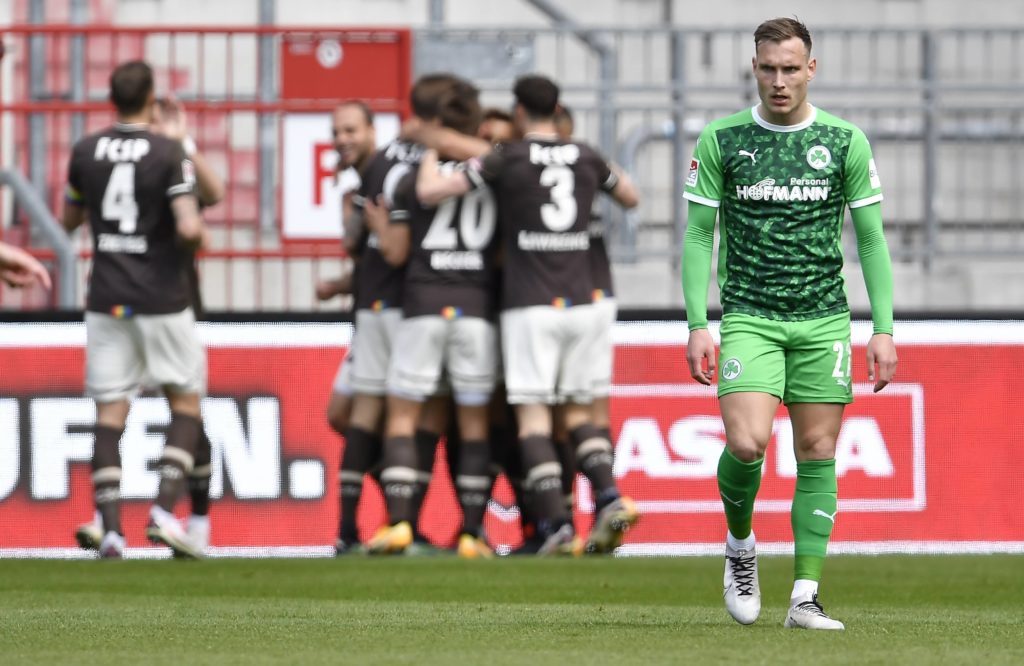
(imago images/via OneFootball)
Dabei lief nach der frühen Führung in der ersten Halbzeit weit alles nicht so rund, wie geplant. 75 Ballverluste stehen in den ersten 45 Minuten in der Liste des FCSP. Das sind enorm viele (Fortuna Düsseldorf hatte im Spiel gegen den FCSP 88x den Ball verloren. Allerdings über die gesamte Spielzeit).
Sinnbildlich für dieses sehr unrunde Spiel war einmal mehr Omar Marmoush. Jeder fünfte Ballverlust ging auf seine Kappe. Eine richtig unglückliche Halbzeit für ihn. Aber er zog sich zusammen mit dem Team wieder aus dieser Phase heraus: Mit Anpfiff zur zweiten Halbzeit zeigte der FCSP ein anderes Gesicht.
Hexer Zalazar und eine wundervolle Zahlenkombination
Als Timo Schultz das erste Mal beim MillernTon zu Gast war, hat er sehr eindrücklich davon berichtet, worauf bei der Entwicklung von Jugenspielern geachtet wird. Er betonte unter anderem, dass Spieler sich mit ihren Skills von anderen Spielern abheben müssen, mit einer Art „signature move“ – wenn ich das besondere Können von Rodrigo Zalazar beschreiben müsste, dann würde ich genau das beschreiben, was kurz nach Anpfiff der zweiten Halbzeit passierte: Zalazar erhielt links hinten den Ball und hatte mehrere Gegenspieler vor sich. Mit einer unnachahmlichen Beschleunigung zog er diagonal nach vorne (einzig Marmoush kann da vom Tempo her mithalten). Keiner konnte ihm folgen. Die Überzahl, die Fürth dort aufgebaut hatte, verpuffte. Er dribbelte bis kurz vor den gegnerischen Strafraum. Während des Dribblings verließen mehrere Spieler ihre Position, weil sie Zalazar anlaufen wollten, der jedoch mit viel höherem Tempo einfach vorbeizog. Dieses Lösen der Gegenspieler aus der Kette sorgte unter anderem dafür, dass Guido Burgstaller völlig blank links am Strafraumeck war.
Die Bewegung von Zalazar, sie ist eigentlich nicht zu verteidigen. Vor allem deshalb nicht, da er immer seinen Körper zwischen Ball und Tor hat. Seine Dribblings funktionieren also ähnlich wie die von Arjen Robben, der als Linksfuß auf rechts spielt. Zalazar macht es andersrum und aus einer tieferen Position. Der Wert dieser Dribblings ist unglaublich hoch und aus dieser Position definitiv ein „signature move„, der ihm sicher die ein oder andere Tür bei (sportlich) höherklassigen Vereinen öffnet.
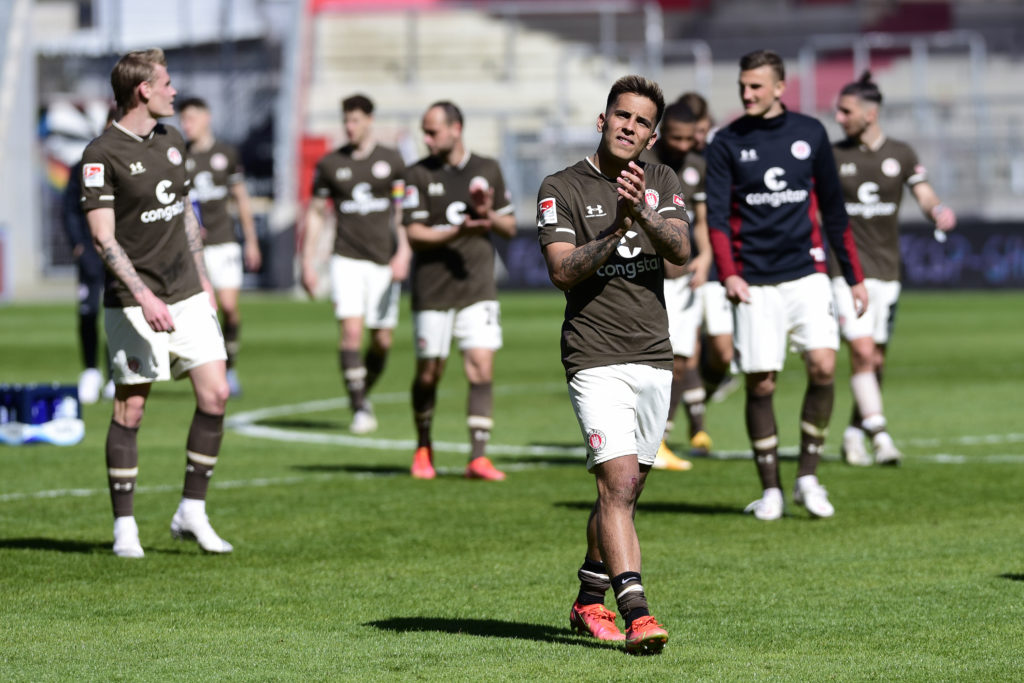
(c) Peter Böhmer
Drei Spiele lang hat Guido Burgstaller nicht getroffen und er hat dabei sämtlichen gesetzten Trigger-Versuchen widerstanden. Aber nicht, weil er es nicht kann, das Toreschießen. Nein, Guido Burgstaller ist einfach ein feiner Kerl, der genau weiß, was sich ziemt, was das FCSP-Herz erwärmt. Denn gestern machte er in seinem 19.Spiel für den FCSP sein 10.Tor – hach, wenn das kein Liebesbeweis ist, dann weiß ich auch nicht.
Und dreimal dürft ihr raten, wie viele Torbeteiligungen Daniel-Kofi Kyereh nach 19 Spielen im FCSP-Dress in der zweiten Liga hatte? Leute, ich bin da einer ganz heißen Sache auf der Spur!
Gegen Kiel könnte Omar Marmoush übrigens seinen 19.Einsatz für den FC St. Pauli machen. Aktuell hat er acht Torbeteiligungen…
Zurück zum Spiel:
Direkt nach dem 2-0 und zwischen der 65. und 75.Minute hatte der FCSP die beste Phase des Spiels und produzierte gute Situationen am Fließband. Ein weiteres, vorentscheidendes Tor entsteht daraus aber leider nicht. Auf der anderen Seite entsteht aber auch wenig Gefahr für das Tor von Dejan Stojanović. Zu gut verteidigte der FCSP viele Situationen, meist immer dann, wenn der Ball das Zentrum erreichte. So darf sich der FCSP am Ende sogar darüber ärgern, dass er sich noch ein Gegentor fing und die richtig gute Abwehrarbeit in der zweiten Halbzeit nicht belohnt wurde.
In der Summe geht dieses Tor aber durchaus in Ordnung, da Fürth in der ersten Halbzeit einige Chancen liegengelassen hat bzw. Stojanović einige Dinger hielt.
Könnt ihr die Tabelle lesen?
Jaja, ich kann die Tabelle lesen. Jaja, solange es möglich ist, möchte auch ich noch aufsteigen und den Funken Hoffnung nicht aufgeben. Aber: Die aktuelle Tabelle suggeriert eine sehr viel größere Chance, als sie es eigentlich ist. Zwar sind es aktuell „nur“ vier Punkte Rückstand, aber der FCSP ist zusammen mit Heidenheim das Team ohne noch zu spielende Nachholpartien. alle anderen Teams darüber können punktemäßig noch weiter wegziehen. Fürth spielt z.B. unter der Woche gegen Sandhausen. Auch der HSV und Düsseldorf haben noch je ein Nachholspiel. Holstein Kiel hat sogar vier Spiele weniger als der FCSP und auch der KSC könnte bei aktuell acht Punkten Rückstand auf Rang drei aber auch drei Spielen weniger noch eher eingreifen als der FCSP.
Da müsste also schon sehr viel richtig laufen für den FCSP, damit da noch was geht. Selbst wenn die letzten drei Spiele allesamt gewonnen werden, ist es eher unwahrscheinlich, dass die anderen Teams sich in Niederlagen überbieten. Ist aber natürlich egal, völlig schnuppe, wie genau wir das nun schaffen und wie aussichtslos die Situation nach 31 Spielen gewesen ist. Denn da Omar im nächsten Spiel ja an zwei Toren direkt beteiligt ist, ist der Anfang bereits gemacht.
Immer weiter vor!
// Tim
Alle Beiträge beim MillernTon sind gratis. Wir freuen uns aber sehr, wenn Du uns unterstützt.
MillernTon auf BlueSky // Mastodon // Facebook // Instagram // Threads // WhatsApp // YouTube
{:}{:en}In a truly really appealing match, FC St. Pauli beats Greuther Fürth. Two early goals after the respective starting whistles aided enormously to that. The way how this lead was kept against one of the best teams of the second division can be described as an accomplished performance. Because besides the goal conceded at a very late stage, the FCSP didn’t allow much to anything during the second half.
(Coverpicture: Peter Böhmer)
The line-up
There were two changes compared to the defeat in Düsseldorf. Instead of Tore Reginiussen, Philipp Ziereis returned into the starting eleven. As Reginiussen wasn’t entirely fit, he didn’t even make it into the squad. On the six, Rico Benatelli started instead of Afeez Aremu.
No changes were made at Greuther Fürth. The slightly injured Paul Jaeckel recovered just in time and was able to play. After the convincing 3-0 against Osnabrück, there wasn’t much incentive to change the line-up though.
So, both teams started with the recently practised 4-4-2 with a midfield diamond. I did wonder in my pre-match report whether the FCSP would possibly react to the very strong diamond of Fürth with a 3-5-2 formation. But this would have been the typical “We rather prepare for the opponent as we do not entirely trust in our own skills” – even after three months, I still have to accommodate to the fact that the FCSP has as well as a well-functioning mode of play so that they don’t have to react completely to the opponent. The fact that I still think this way is because it was exactly done that way for the years. What a pleasure that this changed for the better.

Mirror, Mirror…
It’s rather remarkable how similar both teams aimed to build up, but then, despite the same basic order, embarked on different roads. Both teams pressed relatively high, Greuther Fürth actually very high, so that the FCSP faced some real challenges in their structured build-up play. On the other side, Fürth was able to outplay the high pressing of the FCSP from time to time and then won space on the outer flanks. However, the team then failed due to the well-working defensive centre of the FCSP. This shouldn’t blame the FCSP’s pressing at all as there is a clear development to the better in terms of team behaviour.
I already described frequently that the wing-backs of the opponent are pressed by the half positions which were always Zalazar and Becker in the last couple of matches. This attacking behaviour is still practised. However, only if the opponent’s wing-backs are still rather close to their own goal. When they are positioned further up, FCSP’s wing-backs take over attacking those guys while the players at the half positions stay put in the centre. This attacking behaviour causes that the whole FCSP’s back-line of four has to move towards the side where the ball is. This can then cause further errors if the spaces between the defenders aren’t correct. However, the advantage of still having the half positions in the centre is enormously and the FCSP as a team managed the pressing and the according movements pretty well.
Against Fürth, Zalazar and Becker could thus often stay in the centre. If they somehow, however, pressed against the wing-backs though (if those were positioned deeply in their own half), the coverage of the opponents in the centre was taken over by Zalazar and Paqarada who then moved to the half-positions. This handing-over of the defensive tasks was working pretty well so that Greuther Fürth was partly still able to perform their actually well-working pressing play, however, not in the same frequency compared to the most matches of the season.

left: attacking behaviour if wing-backs were positioned rather deep – if this was the case, the half-positions were still the ones attacking. In this case, FCSP’s wing-backs then moved up to the half-positions.
right: attacking behaviour if wing-backs were positioned high. The centre is kept shut and the wing-backs moved up straight to the opponent’s wing-backs. In this case, the back-line of four had to move towards the ball because otherwise, spaces for deep runs behind their backs would have emerged.
Oops… they did it again
Well, I would easily say, the course of play was rather predictable. At least by those who have read my article of the FCSP’s performance in the respective stages of a match (available in German only). The FC St. Pauli once again showed that they perform pretty strong in the very first minutes of a match so that they didn’t take the lead undeservedly, scored by Luca Zander following up on a corner ball. The FCSP shot three times at the target during the first fifteen minutes, Fürth didn’t shoot at all (xG: 0.47 – 0.0).
But whoever did read the article also knew that the FCSP does almost everything except playing dominantly during the last fifteen minutes of the first half. So this was also true yesterday when Fürth shot at target four times during this phase while the FCSP did not shoot at all. So the fifteen minutes before the break were again the worst performance of the FCSP (xG: 0.0 – 0.56).
Still, I cannot explain how this difference is actually happening which then leads to the fact that the FCSP returns strong from the locker room but enters it very weak. Anyway, of course, I happily accept the lead at half-time. Because this is actually the best that could happen for the FCSP:
I agree with Stefan Leitl
“If you want to win here, you’ll have to take the lead” – Of course, many managers would have thought the same, but no one actually spoke it out loud and clear the way Stefan Leitl, manager of Greuther Fürth did at the post-match press conference. Clearly nagged because of the defeat and because he was asked the same question four times over and over again, he clearly described how difficult it is to play against the FCSP when behind. Because the treasure of the FCSP is and remains the very strong transition play. If a team lies behind and has to risk more, there are inevitable more spaces for counter-attacks. The FCSP could always make use of these emerging spaces because the players of the team are fucking strong in terms of speed. The early goals of the FCSP are perfectly helping in this regard, too.
“Don’t score the decisive goal too early” is happily stated by my blog mate Maik. However, for the FCSP, a game can’t develop any better currently than taking the lead early as this is often enough some sort of pre-decision.

(imago images/via OneFootball)
Anyway, after taking the lead early in the first half, not everything worked out as smoothly as planned. Because there are 75 ball losses during the first 45 minutes in the books for the FCSP. That’s pretty much (Fortuna Düsseldorf lost the ball 88 times when they played against FCSP, however, during the whole match).
Emblematic for this rather scattered play of the FCSP was once again Omar Marmoush. Every fifth ball loss was due to him. A really unlucky half for him. But together with the whole team, he recovered from this phase: When the starting whistle for the second half was blown, the FCSP showed a different face.
Magical Zalazar and a fantastic combination of numbers
When Timo Schultz visited the MillernTon for the first time, he impressively reported what is watched out for in the development of young players. Amongst others, he emphasised that players have to stand out from others in terms of their skills with some sort of “signature move” – If I had to describe the special skills of Rodrigo Zalazar, I would exactly describe what happened shortly after the second half started: Zalazar received a ball on the left in the back and had many players of the opponent in front of him. With an acceleration hard to beat he then moved diagonally to the front (possibly only Marmoush could beat him speed-wise). Nobody was able to follow him. The outnumbering that Fürth did elicit was gone within moments. He then dribbled up to the opponent’s box. And while he was dribbling up there, many opponent left their positions in order to attack him but he simply passed them at high speed. This triggering of the opponents out of their line then caused that Guido Burgstaller was entirely unmarked at the left corner of the box.
This movement of Zalazar is actually not defendable. Mostly due to the fact that he always keeps his body between the ball and the goal. His dribblings thus function in a similar way like those of Arjen Robben who played left-footed on the right. Zalazar does it the other way round and from a deeper position. The value of such dribblings is incredibly high and performed from this position definitely a “signature move” which will certainly open some doors for him at (sportively) higher-ranking clubs.

(c) Peter Böhmer
For three matches in a row, Guido Burgstaller didn’t score and by not scoring he resisted all of my trigger approaches. But definitely not because he isn’t able to score goals. Nope, Guido Burgstaller is simply a fine lad who absolutely knows what makes the heart of an FCSP supporter smile. Because yesterday in his 19th appearance for the FCSP he scored his 10th goal – well if this isn’t a declaration of love what else would be one? And you have three guesses to guess how many goal assists Daniel-Kofi Kyereh had after his 19 appearances wearing the kit of the FCSP in the second division? Guys, I am up to a very hot thing there… By the way, against Kiel, Omar Marmoush could make his 19th appearance for the FCSP. So far he participated in eight goal assists…
But back to the match:
Straight after the 2-0 and between the 65th and 75th minute, the FCSP had its best phase of the match and produced good situations non-stop. But no further, match-decisive goal followed. On the other side, no much danger arose in front of Dejan Stojanović. The FCSP defended too well, mostly when the ball arrived at the centre. In the end, FCSP can worry that they conceded another goal so that their remarkable defensive work during the second half wasn’t paying off totally.
Overall, the conceded goal is okay because Fürth didn’t make use of other promising chances during the first half or because Stojanović defended very well.
Can you read the division’s table?
Yepp, I can read the table. Yepp and as long as it’s technically possible I want to get promoted and not give up on that. But: The current table suggests a much bigger chance than there actually is. At the moment, it’s just “four” points behind but together with Heidenheim, the FCSP is the only team without any postponed matches left, all the other teams up there can even move further up point-wise. For example, Fürth plays against Sandhausen during the next week. Also, HSV and Düsseldorf have another postponed match to play. Holstein Kiel has even four matches less than the FCSP and also KSC, currently eight points behind rank 3 but also with three more matches remaining, can attack even higher than the FCSP.
So there would have to run too many things too smoothly for the FCSP in order to still get promoted. Even if the last three matches will all be won, it’s rather unlikely that all the teams outplay each other in terms of losses. But it doesn’t matter at all how we’ll achieve it and how hopeless the situation was after 31 matchdays played. Because as Omar Marmoush will participate in two goals during his next appearance, there will be a good start.
Keep on moving forward!
//Tim (translated by Arne)
(If not marked differently, all statistics by Wyscout)
MillernTon Twitter //
MillernTon YouTube //
MillernTon Facebook //MillernTon Instagram //
If you like what we do here, here you’ll find the information on how to support us.
{:}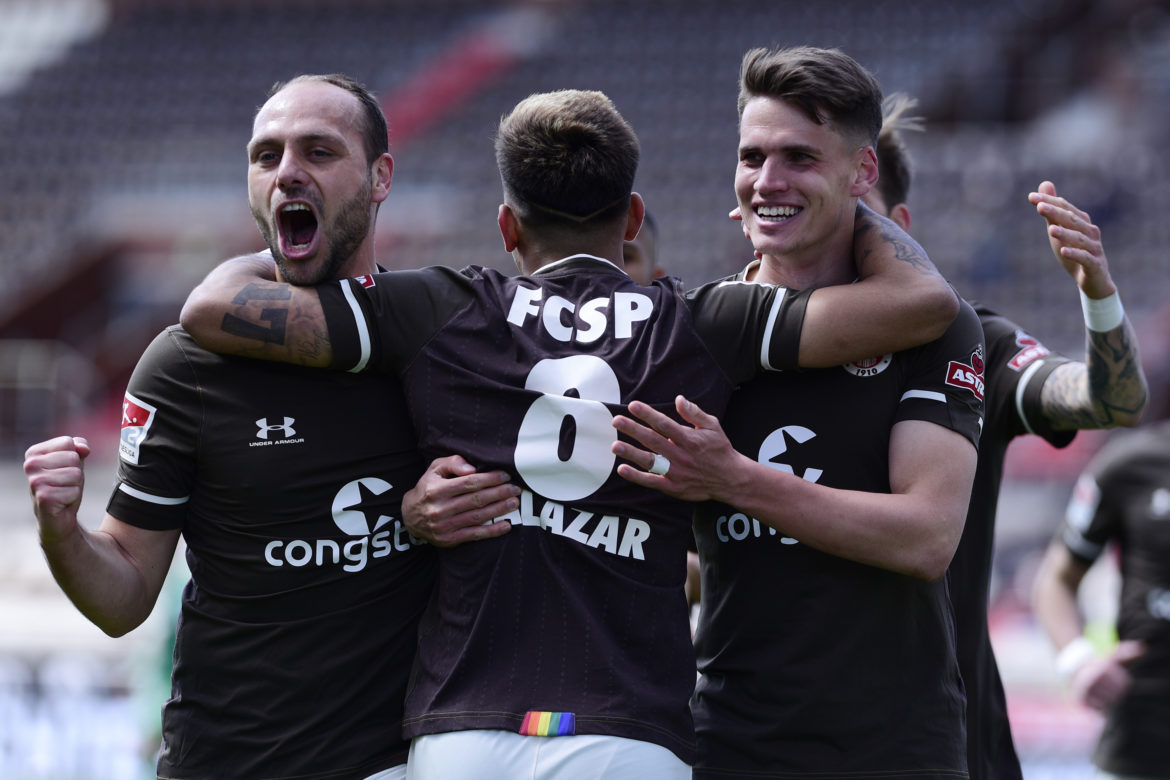

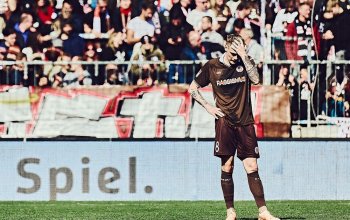
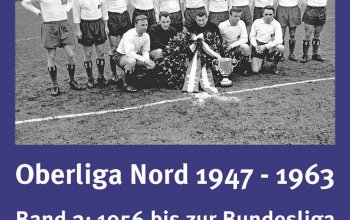

Superbericht wie immer!
Apropos Aufstieg, um noch ein bisschen mehr Motivation im Millernton Team zu erzeugen (weiß nicht ob das nötig ist): ich hab vor der Saison ein bisschen (oder ein bisschen mehr) Geld auf den Aufstieg gesetzt, und denke ich kann dem Millernton 500 Euro spenden falls der Aufstieg noch klappen sollte. Also, drückt die Daumen ?.
Na gut, dann sind wir jetzt auch dafür 😉
Durchschnittliche Punktzahl
der Plätze 1-4 in der BL2 seit
Einführung der 3Pkt-Regel in
der Saison 1995/1996:
1. 68 (1692/25)
2. 62 (1557/25)
3. 60 (1493/25)
4. 57 (1417/25)
56 Punkte werden wohl zu wenig sein,
um noch in die Lotterie „Relegation“ zu
kommen. Mit 59 Punkten sind wir allerdings
1994-95 als Zweiter hinter Hansa (65 P)
aufgestiegen (SUN 15-14-5).
Ja, wird ziemlich sicher eng. Aber hey, ich träume hier den ganzen Tag so vor mich hin…
Moin Tim,
danke. Zu RZ8. Transfermarkt schaut man nicht, shame on me. Jedenfalls kann man anhand der Kurve exponentielles Wachstum erklären.
Bis zum siebten, im Mai.
Moin Tim,
wieder eine schöne Analyse von Dir hier, jedoch bei den Aufstiegsträumereien bin ich absolut nicht dabei, zum einen möchte ich die Geldvereine mittlerweile nicht mehr am Millerntor begrüßen wollen, zum anderen sehe ich lieber Unseren eigenen Nachwuchs erfolgreich hier kicken, dieses wäre in LigaEins dann eher noch unwahrscheinlicher…
„Ich liebe Dich, ich träum von Dir …“
GlG
Micky
Die Klubs, die interessant sind, kommen aktuell eh alle zurück in die 2.Liga. Daher sind wir da schon gut aufgehoben 😉
Moin Tim, klasse Analyse, lese ich immer gerne!
Danke für den Hinweis auf den MT39 mit Schulle, den kannte ich noch nicht und es ist ein große Spaß die Folge zu hören.
VG Tom
Ja, total angenehme Folge